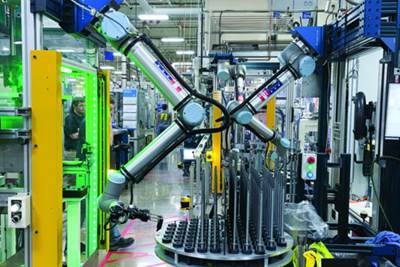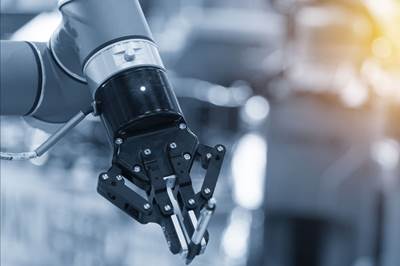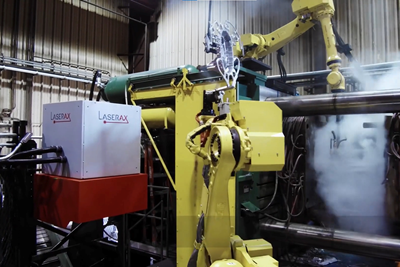-
SPONSORED
-
SPONSORED
Robots and Automation in Metalworking
Machine-tending robots are often key components used to enable unattended or lights-out machining operations, adding capacity by taking advantage of time that’s currently unused, like nights and weekends. In many cases, robot integration enables shopfloor employees that were previously loading and unloading parts from machines to perform duties of greater value. Plus, today’s robots are faster and more intelligent than in years past and are also becoming increasingly viable for small-batch/high-mix production. In addition, collaborative robots, or “cobots,” use sensor technology that enables them function safely alongside humans in a shared work environment. That means no more isolating fencing is needed to separate worker and robot.







ESSENTIAL READING
VIEW ALL4 Manufacturing Trends That Cannot Be Ignored
The next five years will present their own unique set of challenges, and shops can alleviate them by embracing these technologies and trends.
Read MoreBlueprints to Chips: CAD/CAM Tips and Tricks
This collection of articles delves into the latest CAD/CAM innovations, from AI-driven automation and optimized tool paths to the impact of digital twins and system requirements.
Read More4 Steps to a Cobot Culture: How Thyssenkrupp Bilstein Has Answered Staffing Shortages With Economical Automation
Safe, economical automation using collaborative robots can transform a manufacturing facility and overcome staffing shortfalls, but it takes additional investment and a systemized approach to automation in order to realize this change.
Read MoreMade in the USA - Season 1 Episode 2: The Automation Puzzle
There is a fundamental question we need to answer when we talk about automation: To what extent is automation an answer to the skilled workforce shortage, and to what extent is automation vs. Skilled labor the wrong comparison to make in the first place?
ListenChoosing a Five-Axis Machine Tool With Automation in Mind
While much focus is placed on the machinery that moves parts, the features most important for automating five-axis machining are arguably found in the machine tool itself.
Read More5 Tips for Automating Laser Marking With Robots
Automating laser marking can be a useful way to increase robots’ utilization, but the process requires careful planning for success.
Read MoreLatest Automation News And Updates
Edge Technologies Bar Feeder Streamlines CNC Swiss Lathe Automation
Eastec 2025: The FMB Turbo RS 3-38 provides full support of the bar pusher and stock from inside the bar feeder all the way into the lathe spindle.
Read MoreSW North America Twin-Spindle Machining Center Enables Fully Autonomous Operation
Eastec 2025: The BA 322i is well suited for machining complex aerospace components that require tight tolerances and high-quality finishes.
Read More3 Trends From PMTS 2025
The 2025 Precision Machining Technology Show provided an excellent look at the variety of machining solutions catering to the U.S. metalworking industry, including a range of automation solutions for turned and milled parts.
WatchEnhancing the Shop Floor with AI
How can AI and digital twins use data gathered on the shop floor? Learn how these digital tools can improve efficiency through programming, maintenance, sustainability and more.
Read MoreAMRs Are Moving Into Manufacturing: 4 Considerations for Implementation
AMRs can provide a flexible, easy-to-use automation platform so long as manufacturers choose a suitable task and prepare their facilities.
WatchEdge Technologies Bar Feeder Enhances Small-Diameter Bar Stock Applications
PMTS 2025: The FMB Turbo RS 2-20 fully supports the bar pusher and stock from within the bar feeder to the lathe spindle.
Read MoreFeatured Posts
4 Manufacturing Trends That Cannot Be Ignored
The next five years will present their own unique set of challenges, and shops can alleviate them by embracing these technologies and trends.
Read MoreBlueprints to Chips: CAD/CAM Tips and Tricks
This collection of articles delves into the latest CAD/CAM innovations, from AI-driven automation and optimized tool paths to the impact of digital twins and system requirements.
Read More3 Machine Options to Aid Automation
Don’t overlook controller options, process security options and coolant handling when staring down the line items of a new machine purchase.
Read MoreKUKA Automation Tech Day Highlights the Power of Integrated Automation Technologies
A demonstration of an automated machining cell showed the power of combining vision systems, robots and AMRs.
WatchThree Features That Maximize Unattended Machining on Palletized Machines
Probing and laser systems, large tool magazines, and pallets with multiple parts enable users to run pallet systems for longer periods of time, increasing spindle uptime.
Read MoreThe Four Phases of a Manufacturer’s Automation Evolution
With more and more automation options available for manufacturers, how do shops figure out what works best? Medical manufacturer rms Company has acquired robot arms, AGVs, pallet changers and software, and while it has found success with all, it has learned how some solutions meet its particular needs better than others.
Read MoreFAQ: Automation
What is automation?
“Robot” is the first picture that comes to mind, but it means more than that. Automation could be machines that are able to do more in one setup, one handling. It also refers to other options like pallet systems for moving work around, in and out of machines. It refers to software that can automate certain operations. Automation is not a replacement or an alternative for people.
What is a cobot?
A collaborative robot or “cobot” is a robot that is safe to run unguarded near people. Most cobots are safe because they are speed- and force-limited, and they stop upon sensing contact with an obstacle. Cobots are also easy to relocate and reprogram for different tasks in a shop.
What should you know about cobots?
1. Cobots, vision and AI all go together.
2. Cobots do not guarantee safety.
3. Cobot applications need not feature collaboration.
4. Automation’s payback period is declining.
5. Trends in manufacturing favor collaboration.
6. Cobot adoption might be held back by lack of people.
7. Advancing AGV technologies make cobots mobile.
8. Attention recognition is coming.
9. Collaborative can be done in different ways.
10. “Collaborative” can be a bigger idea.
How do robots and 3D printing intersect?
1. 3D Printed End-of-Arm Tooling (EOAT)
2. 3D Printed Off-Robot Accessories
3. Robot-Tended 3D Printers
4. Robots As 3D Printing Systems




























